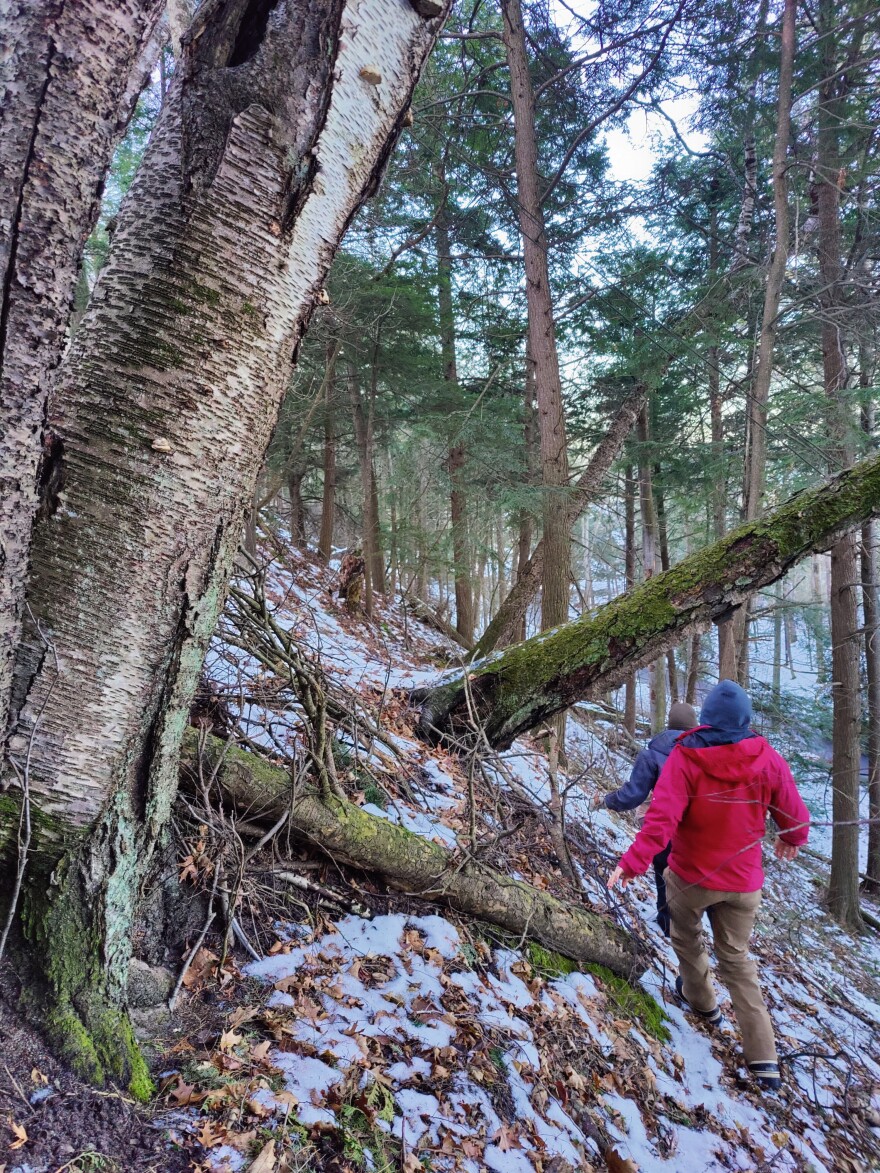The Crystal Downs Country Club is right on Lake Michigan, north of Frankfort.
It has beachfront properties – mostly seasonal homes – and a steep forested hill that leads up to a golf course.
It’s usually a pretty quiet place in the winter. But today, a line of cars is parked at the bottom of a grove of hemlock trees along the hillside.
SUSPICIOUS TREES
Last week, two employees with the Northwest Michigan Invasive Species Network were out here looking for signs of hemlock woolly adelgid – a tiny bug that’s causing big problems.
“It's a sap sucking insect,” said Murielle Garbarino with the Invasive Species Network. “So it will attach at the base of the needle and it has sucking mouthparts and will take nutrients from the tree.”
Garbarino was on that survey last week, and made an unfortunate discovery.
“It was like any other survey that we do: We check up to 30 hemlock trees per acre,” Garbarino said. “And we found a tree that looked suspicious.”
Suspicious because of a fluffy white material that had accumulated on the underside of a branch. These are the egg sacs of the Hemlock Woolly Adelgid, called HWA for short.

When the little sap suckers start feeding on a hemlock, the tree notices and does some self-pruning. It sheds its needles from the infected branch, which eventually drops to the forest floor.
“But if HWA spreads throughout the entire tree, that leads to the entire tree dying,” Garbarino said. “And it takes about five to 10 years for HWA to kill a hemlock tree.”
Unless those trees are injected with pesticide.
TREATING THE BUG
The crew here today is marking and measuring hemlocks within 800 feet of that original infected tree, which will all be treated with pesticide this spring. And if any of those trees also show signs of HWA, they’ll survey another 800 foot radius around that tree.
It’s a laborious process, especially on this steep terrain. But it's worth it to protect this iconic evergreen, said Garbarino.
“Hemlocks are very important for wildlife in the winter,” Garbarino said. “They have really dense canopies, so deer often like to bed down underneath hemlocks. They also will grow along streams, and they're really important for cooling streams because they shade the streams and keep the snow cover longer.”
Longer snow cover helps keep streams colder. That’s important for species like trout, which need coldwater streams to survive.
“They’re also just beautiful trees,” said Garbarino.
The crew split into groups of three, and started scouring the hillside. It was a little icy, and it took all of their limbs to keep balance.

One crew member was Bri Jasinski with the Mason-Lake Conservation District. Until last week, Mason was the northernmost county where HWA had been detected. But once it was spotted in Benzie County, she headed north to help.
“Currently, we’re the ones that have the gear to treat it,” said Jasinski. “It’s a multi-partner effort along the lake shore.”
As the group approached a tree, they measured its diameter at breast height – that’s “DBH” for short, in forestry lingo.
“So for every single inch DBH that it is across, it gets two milliliters of the chemical treatment,” Jasinski said. “So that tells you how many holes you're gonna drill in it, and then how much chemical.”
Once the tree is injected, it sucks up that pesticide, and distributes it throughout all its branches. So when the adelgids start sucking on the sap, they’re also ingesting a lethal poison. The injections will protect the tree for five to seven years. And after that, it’ll have to be treated again.
Wednesday’s efforts were getting things staged for the chemical treatment later. After a tree’s DBH was measured and recorded, Jasinski used a hammer and nail to stake a little metal tag into the tree, with an identifying number.

HOW THE BUGS MOVE
Jasinski said there are a few ways these bugs can move from one grove of hemlocks to another; they can’t move very far on their own.
It can move by wind, it can be brushed against by animals or people hiking and be carried that way,” Jasinski said. “It can also be moved by birds. The migrational patterns of birds is right up and down the lake shore, so that can carry it.”
One other way that HWA can spread is through landscaping. When a property owner decides to plant a hemlock tree, it’s possible that sapling is infected. That’s why the Michigan Department of Agriculture and Rural Development has imposed a quarantine on six counties where HWA has been detected. That quarantine will soon include Benzie County.
“Anybody that's growing hemlock nursery stock within those counties or that wants to move it, we have to go out, physically look at it, check their paperwork and inspect it,” said Zach Grime, a plant industry inspector with the department. “So we try to mitigate that risk as much as we can.”
Grime said another way to prevent the further spread of HWA is through education. That’s why the Northwest Michigan Invasive Species Network will host a public survey training event near Lake Ann.
It's good to have members of the public know about HWA and know what to look for,” said Murielle Garbarino with the Invasive Species Network. “Because we can't look at every hemlock tree in northern Michigan.”
To learn how to keep an eye on the hemlocks in your neck of the woods, head to the Almira Township Hall at 10 AM on March 11.



